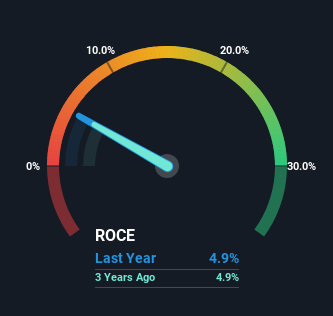
If you're looking at a mature business that's past the growth phase, what are some of the underlying trends that pop up? Typically, we'll see the trend of both return on capital employed (ROCE) declining and this usually coincides with a decreasing amount of capital employed. This combination can tell you that not only is the company investing less, it's earning less on what it does invest. So after glancing at the trends within PPL (NYSE:PPL), we weren't too hopeful.
Return On Capital Employed (ROCE): What Is It?
Just to clarify if you're unsure, ROCE is a metric for evaluating how much pre-tax income (in percentage terms) a company earns on the capital invested in its business. Analysts use this formula to calculate it for PPL:
Return on Capital Employed = Earnings Before Interest and Tax (EBIT) ÷ (Total Assets - Current Liabilities)
0.049 = US$1.8b ÷ (US$40b - US$2.4b) (Based on the trailing twelve months to March 2024).
Thus, PPL has an ROCE of 4.9%. On its own that's a low return on capital but it's in line with the industry's average returns of 4.8%.
View our latest analysis for PPL

In the above chart we have measured PPL's prior ROCE against its prior performance, but the future is arguably more important. If you're interested, you can view the analysts predictions in our free analyst report for PPL .
What Does the ROCE Trend For PPL Tell Us?
In terms of PPL's historical ROCE movements, the trend doesn't inspire confidence. About five years ago, returns on capital were 7.6%, however they're now substantially lower than that as we saw above. Meanwhile, capital employed in the business has stayed roughly the flat over the period. Since returns are falling and the business has the same amount of assets employed, this can suggest it's a mature business that hasn't had much growth in the last five years. If these trends continue, we wouldn't expect PPL to turn into a multi-bagger.
The Key Takeaway
In summary, it's unfortunate that PPL is generating lower returns from the same amount of capital. Despite the concerning underlying trends, the stock has actually gained 23% over the last five years, so it might be that the investors are expecting the trends to reverse. Regardless, we don't like the trends as they are and if they persist, we think you might find better investments elsewhere.
One more thing: We've identified 3 warning signs with PPL (at least 2 which can't be ignored) , and understanding these would certainly be useful.
While PPL isn't earning the highest return, check out this free list of companies that are earning high returns on equity with solid balance sheets.
New: Manage All Your Stock Portfolios in One Place
We've created the ultimate portfolio companion for stock investors, and it's free.
• Connect an unlimited number of Portfolios and see your total in one currency
• Be alerted to new Warning Signs or Risks via email or mobile
• Track the Fair Value of your stocks
Have feedback on this article? Concerned about the content? Get in touch with us directly. Alternatively, email editorial-team (at) simplywallst.com.
This article by Simply Wall St is general in nature. We provide commentary based on historical data and analyst forecasts only using an unbiased methodology and our articles are not intended to be financial advice. It does not constitute a recommendation to buy or sell any stock, and does not take account of your objectives, or your financial situation. We aim to bring you long-term focused analysis driven by fundamental data. Note that our analysis may not factor in the latest price-sensitive company announcements or qualitative material. Simply Wall St has no position in any stocks mentioned.
About NYSE:PPL
PPL
Provides electricity and natural gas to approximately 3.5 million customers in the United States.
Solid track record with limited growth.
Similar Companies
Market Insights
Community Narratives



